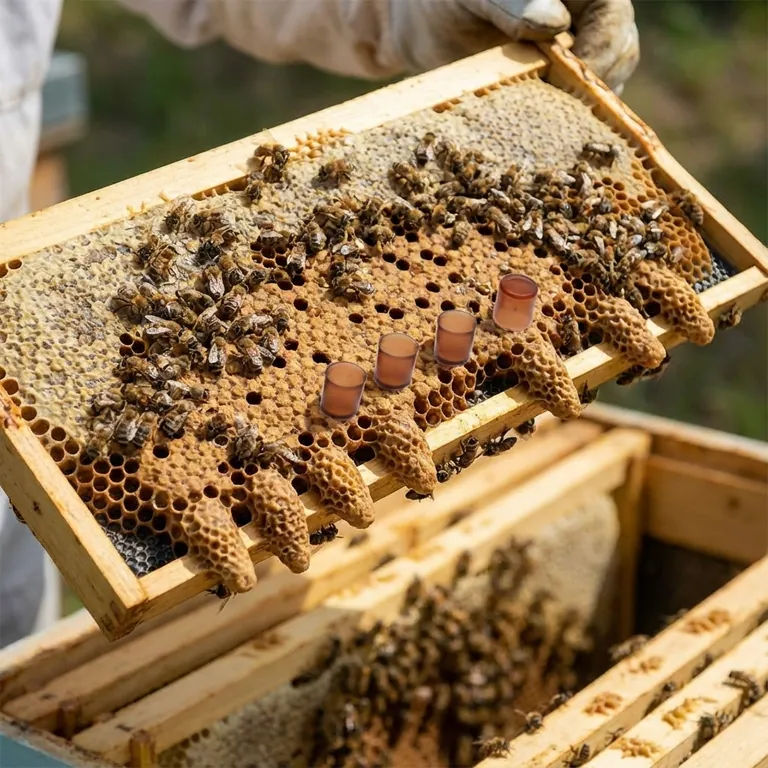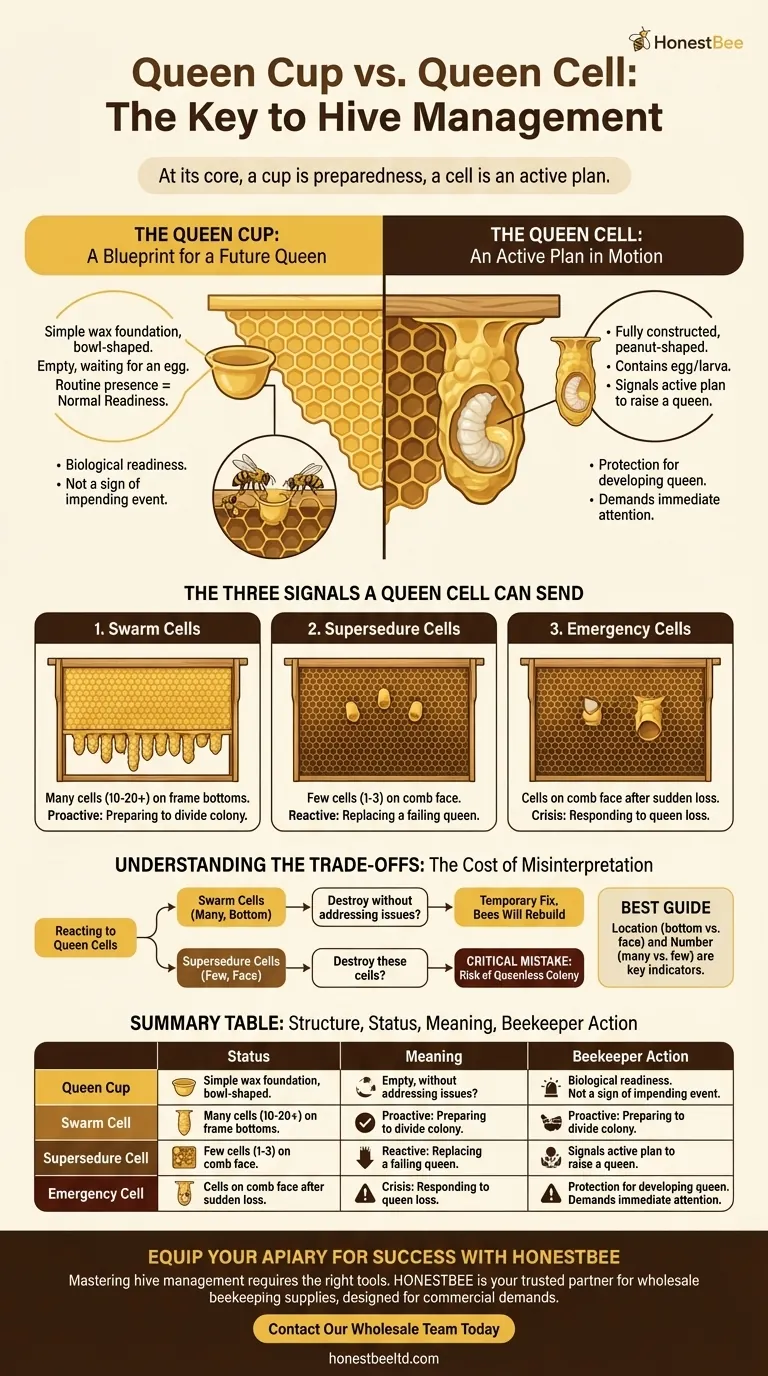At its core, a queen cup is the simple wax foundation for a potential queen, while a queen cell is the fully constructed, elongated structure actively housing a developing queen larva. A cup represents a colony's preparedness for a new queen, but a cell signals an active plan to raise one. Seeing cups is routine; seeing cells demands your immediate attention.
Understanding the difference is not just a matter of terminology. It is the key to interpreting your hive's most critical intentions—whether they are planning to swarm, replacing a failing queen, or responding to a sudden emergency.

The Queen Cup: A Blueprint for a Future Queen
A queen cup is the very beginning of the process. Think of it as the empty foundation of a house waiting to be built.
What is a Queen Cup?
A queen cup is a small, downward-facing, bowl-shaped structure made of beeswax. It is about the size and shape of the tip of your pinky finger.
Worker bees build these instinctively in healthy colonies. They are often found along the bottom edges of frames or in divots on the comb face.
Why Do Bees Build Them?
Bees build queen cups as a form of biological readiness. By having these foundations ready, they can respond quickly if the need to raise a new queen arises.
The mere presence of empty queen cups is not a cause for alarm. It is a sign of a normal, forward-thinking colony, not necessarily one that is about to swarm or replace its queen.
The Queen Cell: An Active Plan in Motion
A queen cup transitions into a queen cell the moment the colony decides to act. This is the point where potential becomes an active project.
From Cup to Cell
A cup officially becomes a cell once a queen lays a fertile egg inside it. The worker bees then begin to feed the resulting larva a special diet of royal jelly and draw out the wax cup into a much longer, peanut-shaped structure.
This completed structure, which hangs vertically from the comb, is the queen cell. It protects the developing queen through her larval and pupal stages.
The Three Signals a Queen Cell Can Send
The location and number of queen cells are critical clues that reveal the colony's motivation. There are three primary types.
1. Swarm Cells
These are built when a strong, populous colony prepares to divide through swarming. You will typically find many swarm cells (often 10-20+) located along the bottoms and sides of the frames. This is a proactive measure by a thriving colony to propagate itself.
2. Supersedure Cells
These are built when the bees decide their current queen is failing—her egg-laying rate has dropped or her pheromones are weak. You will typically find only a few supersedure cells (usually 1-3) located on the face of a comb. This is a reactive measure to ensure the colony's survival by replacing a weak leader.
3. Emergency Cells
These are built when the queen is suddenly and unexpectedly killed or removed. In this crisis, worker bees will quickly modify an existing worker-larva cell, which starts horizontally, and draw it downwards into a queen cell. These are found on the face of the comb and signify a dire situation.
Understanding the Trade-offs: The Cost of Misinterpretation
Reacting incorrectly to queen cells can have severe consequences for your colony. Correctly identifying the bees' intent is one of a beekeeper's most important skills.
Swarm Cells vs. Supersedure Cells
The most common point of confusion is differentiating between swarm and supersedure cells. Destroying swarm cells without addressing the underlying issue (like overcrowding) is a temporary fix; the bees will simply build more.
However, destroying supersedure cells is a critical mistake. You are actively working against the bees' attempt to save their colony from a failing queen. This can lead to the colony becoming queenless and eventually dying out.
Location and Number are Your Best Guide
Always rely on the two primary indicators:
- Location: Are the cells on the bottom of the frame (likely swarm) or on the face of the comb (likely supersedure/emergency)?
- Number: Are there many cells (likely swarm) or just a few (likely supersedure)?
How to Respond Based on Your Hive's Status
Your response should be dictated by what the bees are telling you.
- If you find empty queen cups: Note their presence but take no action, as this is normal preparation and not a sign of an impending event.
- If you find multiple swarm cells on the bottom of frames: Your colony is preparing to swarm; you must act to prevent losing half your bees by splitting the hive or providing more space.
- If you find a few supersedure cells on the face of the comb: Your bees are replacing a failing queen; the wisest course of action is often to allow them to proceed.
- If you find emergency cells after a recent inspection: You likely lost your queen. Confirm she is gone and allow the bees to raise a new one, or consider introducing a new mated queen.
Mastering this distinction elevates you from simply keeping bees to truly managing a healthy and productive colony.
Summary Table:
| Structure | Status | What It Means | Beekeeper Action |
|---|---|---|---|
| Queen Cup | Empty foundation | Normal colony preparedness | Monitor, no immediate action needed |
| Swarm Cell | Many cells on frame bottoms | Colony is preparing to swarm | Split hive or provide more space |
| Supersedure Cell | Few cells on comb face | Replacing a failing queen | Often best to allow the process |
| Emergency Cell | Cells on comb face after queen loss | Responding to a sudden crisis | Confirm queen loss, allow replacement |
Equip Your Apiary for Success with HONESTBEE
Mastering hive management starts with having the right tools. Whether you're a commercial beekeeper managing hundreds of colonies or a distributor supplying the industry, misinterpreting queen cells can lead to significant losses.
HONESTBEE is your trusted partner in beekeeping success. We supply durable, high-performance beekeeping supplies and equipment through wholesale-focused operations, designed specifically for the demands of commercial apiaries and equipment distributors.
Let us help you build a more resilient and productive operation.
Contact our wholesale team today to discuss your specific needs and discover how our equipment can support your colony management goals.
Visual Guide

Related Products
- Brown Nicot Queen Cell Cups for Breeding Queen Bees Beekeeping
- Clear Black Plain Polystyrene Queen Bee Grafting Cell Cups No Lug for Bee Queen Cup
- Plastic Chinese Queen Grafting Tool for Bee Queen Rearing
- High Performance Plastic Queen Excluder for Beekeeping and Apiary Management
- Heavy Duty Stainless Steel Queen Bee Catcher Clip
People Also Ask
- How are the queen cells raised after removing the plugs? Master the Art of Queen Rearing
- What is the advantage of the Nicot Cupkit system? Secure Your Queen Rearing Success with Batch Protection
- What is the benefit of inducing supersedure by giving a queenright colony a protected queen cell? A Seamless Requeening Method
- What role does the natural swarming process play in queen rearing? Harness the Swarm Instinct for Better Queens
- Why is it important to select a healthy larva less than 24 hours old for queen rearing? Maximize Queen Quality and Colony Strength






